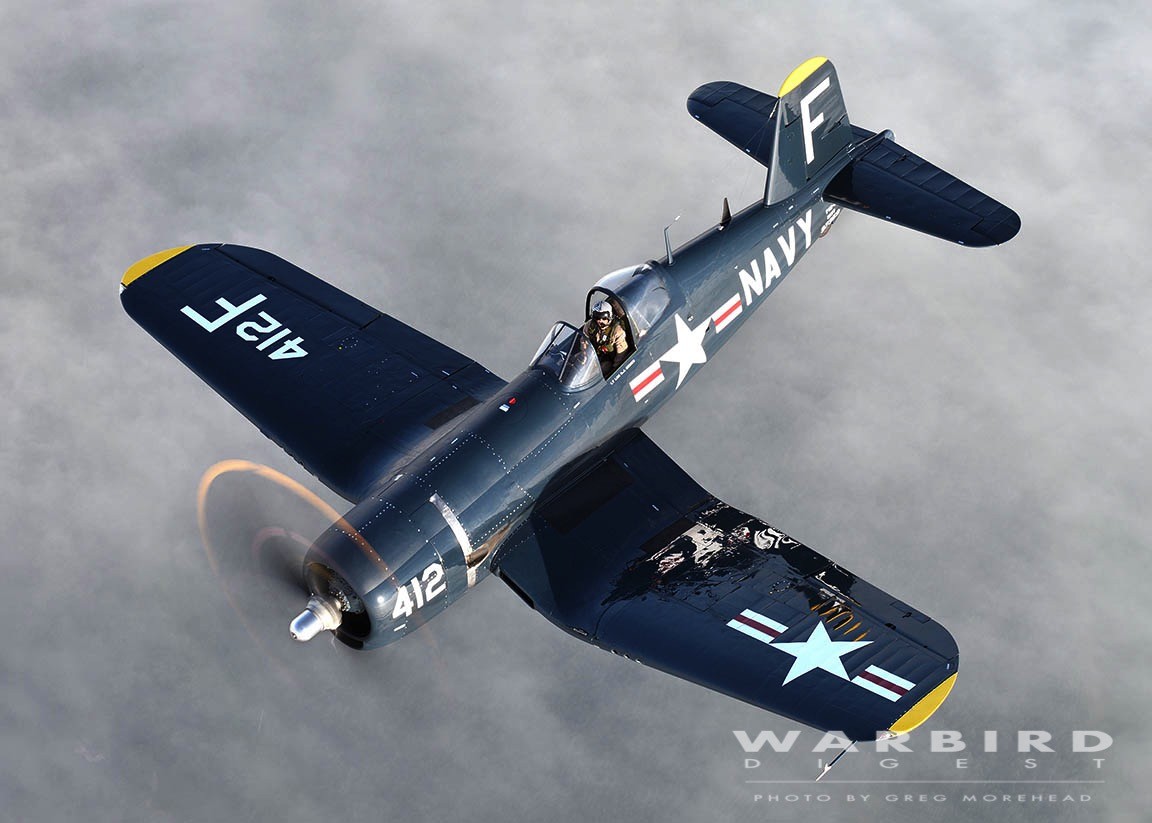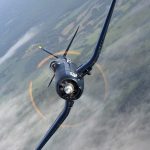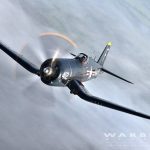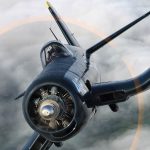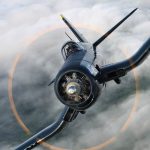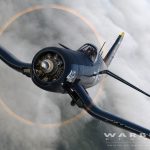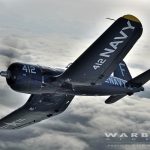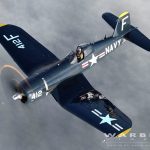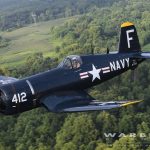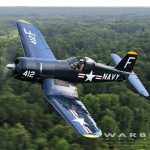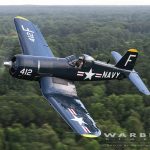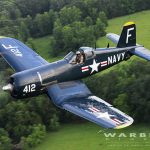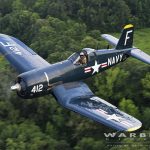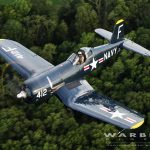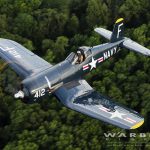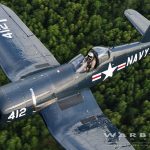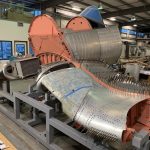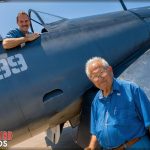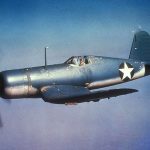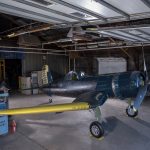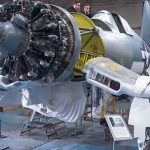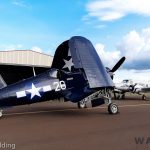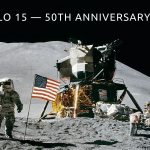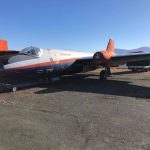By Greg Morehead and Stephen Chapis
Battle lines changed daily during the early dark days of the Korean War, as Allied forces endured brutal combat with their North Korean and Communist Chinese foe, whose numbers too often far outstripped their own. Frequently coming to their rescue from the air, especially during the retreat at Chosin in November 1950, US Navy and Marine Corps F4U Corsairs launched from carriers offshore to help their brethren on the battlefield.
This specific aircraft, Vought F4U-4 BuNo 97359, departed EAA AirVenture Oshkosh 2021 with the “Best Navy Fighter” award, but its military history dates to March 12, 1946, when the U.S. Navy first accepted it for service. However, the fighter flew into storage at NAS Tillamook, Oregon, and then Santa Ana, California. After a four-month stint in the pool and FASRON 7 at NAS North Island in San Diego, ‘359 finally received a squadron assignment when it was attached to the Hellrazors of VA-13A at North Island in April 1948. She remained with this unit until May 1949, by which time the squadron had relocated to NAS Jacksonville, Florida.
In March 1950, the Corsair went into storage once again, this time in Litchfield Park, Arizona. On October 18, 1950, the fighter was assigned to VMT-2 at Marine Corps Air Station (MCAS) El Toro, California, thus beginning a two-year stint with the U.S. Marines. After refurbishment in San Diego and Jacksonville, ‘359 was assigned to VF-44 Hornets at NAS Jacksonville, Florida on January 28, 1953, and saw extensive action from the decks of USS Lake Champlain (CV 39) and USS Boxer (CV 21) during the closing months of the Korean War. In the final years of its career, ‘359 served with VF-74 at NAS Quonset Point, Rhode Island, VX-2 at NAS Chincoteague, Virginia, and Reserve squadrons in San Diego, California and Olathe, Kansas. The Navy finally struck her from their books at Litchfield Park in July 1956 with 1,798 hours on the airframe.
But the scrap man’s torch was not in her future. In November 1957, the legendary character, Bob Bean, purchased the fighter for $1,500.99 and stored it outside for the next 19 years until Tom Friedkin purchased the aircraft on November 19, 1975. Less than a year later, this Corsair made its television debut on Flying Misfits, the two-hour pilot episode for the television series which became Baa Baa Black Sheep. By the time the series ended in April 1978, the fighter had appeared in 35 of 36 episodes. The Corsair remained in the Friedkin family collection until January 1988, when they sold it to the Old Flying Machine Company based in Duxford, England. Here the aircraft flew, oddly, in WWII-era Royal New Zealand Air Force markings. However, this was to be a brief overseas jaunt, as the fighter returned home to the US in 1992 and, over the next two decades, passed through several different owners, including Norm Lewis and Max Chapman. In 2006, the Corsair briefly reunited with its former Black Sheep co-star, FG-1D BuNo 92106, in Vintage Wings of Canada’s stable at Gatineau Executive Airport in Quebec, Canada. In March 2008, former Vintage Wings of Canada regular, Doug Matthews, purchased the aircraft and had it repainted to represent the Corsair flown by VF-32 pilot Lt (j.g.) Thomas Hudner on his Medal of Honor mission of December 4, 1950.
In 2010, it was discovered that retired Navy Commander Charles “Obie” O’Brien, a pilot then-flying with the Virginia Beach-based Military Aviation Museum (MAM), had flown this Corsair on three of his twenty-four combat missions over North Korea in June and July 1953. Obie, 83-years-old at the time, was the last pilot in the world who had both flown Corsairs in combat and was still actively flying the type six decades later. When fellow naval aviator Doug Matthews heard about Obie he said without hesitation, “Well he has to fly it again.”
So on Saturday, September 22, 2012, Obie climbed aboard 97359 and expertly brought the aircraft’s Pratt & Whitney R-2800 to life. Over the previous decade, Obie had logged more than 100 hours at the controls of the MAM FG-1D, but this flight was different. It was special. He was, once again, about to fly the very same Corsair he had flown into the teeth of enemy anti-aircraft fire nearly six decades earlier.
A year later, however, Matthews sold the Corsair on to Oklahoman Trent Latshaw. The Corsair flew less than 100 hours in the following ten years before the American Honor Foundation of Ocala, Florida acquired it. Upon learning that there was a living Korean War veteran who had flown ‘359 in combat and who’d also flown Corsairs into his mid-80s, officials at the American Honor Foundation chose to honor Obie, and his VF-44 squadron-mates, by repainting the Corsair to represent how it appeared in those closing months of the Korean War. With Obie’s name on the canopy rail, the combat veteran fighter made its public debut at EAA AirVenture Oshkosh 2021, featuring at the famous Warbirds In Review on July 23, 2021.
The repaint took place early in July 2021. The airplane flew to John Mosley’s paint shop, Hangar 360 Aircraft Services, to regain its wartime identity. The squadron markings, aircraft number, and even Obie’s name under the canopy completed the long-overdue tribute. Warbird Digest photographer Greg Morehead traveled to Raymond, Mississippi to document its first flight in these markings. While this Corsair might technically be part of the American Honor Foundation’s collection, to them it will always be “Obie’s Corsair.”







